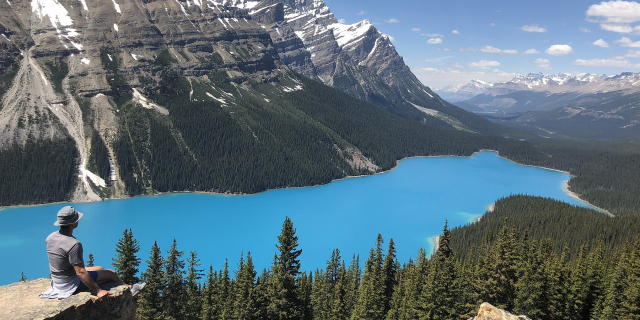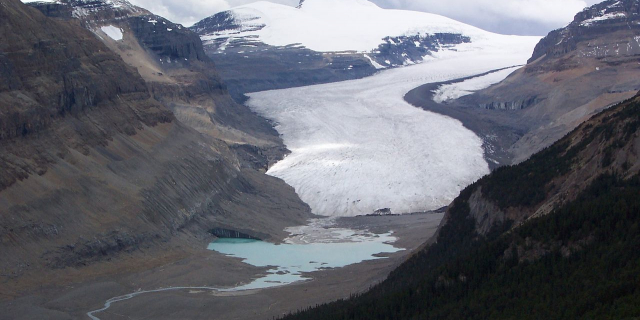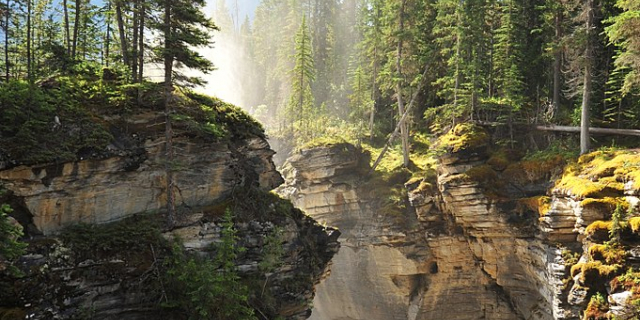Glacier National Park is part of a system of 43 parks and park reserves across Canada, and one of seven national parks in British Columbia. Established in 1886, the park encompasses 1,349 km2 (521 sq mi), and includes a portion of the Selkirk Mountains which are part of the larger grouping of mountains, the Columbia Mountains. It also contains the Rogers Pass National Historic Site.
The park's history is closely tied to two primary Canadian transportation routes, the Canadian Pacific Railway (CPR), completed in 1885, and the Trans-Canada Highway, completed in 1963. Rogers Pass in the centre of the park eluded explorers until 1881. The railway brought with it tourism, the establishment of Glacier National Park and the construction of a popular alpine hotel. The heavy winter snows and steep, avalanche-prone valleys of the park have been a major obstacle to transportation, necessitating much railway engineering and avalanche co...Read more
Glacier National Park is part of a system of 43 parks and park reserves across Canada, and one of seven national parks in British Columbia. Established in 1886, the park encompasses 1,349 km2 (521 sq mi), and includes a portion of the Selkirk Mountains which are part of the larger grouping of mountains, the Columbia Mountains. It also contains the Rogers Pass National Historic Site.
The park's history is closely tied to two primary Canadian transportation routes, the Canadian Pacific Railway (CPR), completed in 1885, and the Trans-Canada Highway, completed in 1963. Rogers Pass in the centre of the park eluded explorers until 1881. The railway brought with it tourism, the establishment of Glacier National Park and the construction of a popular alpine hotel. The heavy winter snows and steep, avalanche-prone valleys of the park have been a major obstacle to transportation, necessitating much railway engineering and avalanche control measures.
The park contains high peaks, large, active glaciers, and one of Canada's largest cave systems. Its dense forests support populations of large mammals, birds, and alpine species. The region is noted for its heavy snowfall. The park has an extensive network of trails, three campgrounds, and four backcountry huts and cabins. Due to the major transportation routes that bisect it, Glacier National Park sees large numbers of visitors.
The Selkirk Mountains were first noted by Europeans when explorer David Thompson of the North West Company skirted around them on the Columbia River in 1811. He named them Nelson's Mountains, after Lord Horatio Nelson, but they were later renamed after an executive for the rival Hudson's Bay Company, Lord Thomas Douglas Selkirk.[1]
Finding a pass through the Selkirks became a priority after construction of the Canadian Pacific Railway began. Completion of the railway was a condition of the Colony of British Columbia upon entering Canadian Confederation in 1867. In 1865, Canadian Pacific Surveyor Walter Moberly led an expedition up the Illecillewaet River (which he named, using the Okanangan word for "swift water"). Despite recently discovering Eagle Pass through the nearby Monashees, Moberly failed to find a pass through the Selkirks after getting sidetracked in the Tangier Creek drainage. His party refused to explore further due to the lateness of the season, and Moberly was forced to retreat.[2]
Rogers PassAn expedition led by Major Albert Bowman Rogers up the Illecillewaet discovered a viable pass in 1881. Rogers was awarded a five thousand dollar prize for locating a route through the mountains.[3] In 1885, the CPR constructed a line through Rogers Pass and the following year trains were travelling west to the Pacific for the first time in Canada. The federal government and the CPR quickly realized the tourism potential of the mountainous, heavily glaciated area. Following a trip by Prime Minister John A. Macdonald and his wife Agnes through the Rockies on the newly completed Trancontinental Railroad, he returned to Ottawa inspired, and led the creation of Glacier and Yoho National Parks, both established on October 10, 1886. They were the second and third national parks in the country, after Banff, a year earlier.[4]
Glacier House Glacier House in 1909
Glacier House in 1909The grade of the railway approaching Rogers Pass was too steep to allow for dining cars on the trains, so the CPR built a hotel west of the pass in 1886. This added to a collection of CPR-owned hotels across Canada, including Mount Stephen House in Yoho National Park, built in the same year and with the same floor plan. Glacier House, located near the terminus of the Illecillewaet Glacier (called the Great Glacier at the time), became a centre for tourism, mountaineering, glaciology, and photography in the Selkirks. The hotel was expanded in 1905 and 1911. It was considered one of western Canada's premier tourist destinations at the turn of the twentieth century.[5]
The hotel attracted alpinists from around the world. Owing to its elevation, climbers could be in the high alpine within hours of leaving their room. In 1899, the CPR contracted the services of several Swiss guides to assist the less mountain-savvy tourists through the high country. Throughout the Glacier House period, many first ascents were made on peaks within the park. The hotel also attracted naturalists and scientists keen to study the mountain environment. Mary Vaux Walcott and her brothers, George and William Vaux, visited the area many times, and began the first scientific studies of the Illecillewaet Glacier.[6]
MountaineeringGlacier House is considered "the first center (sic) of alpinism" in North America by American Alpine Club historian William Lowell Putnam.[7] It saw an influx of European and American professional climbers in its first two decades of operation. William Spotswood Green was the first European climber to make note of the excellent climbing possibilities of peaks near the CPR line. Green and Henry Swanzy made the first recorded ascents of major peaks in the summer of 1888, climbing Mount Bonney and Green's Peak. Harold Topham, a British climber, made many first ascents in 1890 including Mount Fox; he later joined with Henry Forster, and two Swiss climbers, Emil Huber and Carl Sulzer to explore the southern peaks of the park. Huber and Sulzer also claimed the prized first ascent of the dramatic Mount Sir Donald.[8]
Arthur Oliver Wheeler, a cartographer, climber, and founding member of the Alpine Club of Canada (ACC), came to Glacier House in 1901. This started a thirty-year relationship with the northern Selkirks, which saw Wheeler map the region, publish large reference works on its geography, and explore much of the park's terrain.[9] An ACC hut near the Illecillewaet campground bears his name, as well as a peak and a pass. Professor Charles Ernest Fay, first president of the American Alpine Club, after visiting the park in the 1890s, publicized it in the club's magazine.[10] By the 1900s, almost all of the park's prominent peaks had seen human tracks.
Connaught Tunnel and the Trans-Canada Highway CPR workers attempt to rescue buried colleagues in the 1910 Rogers Pass avalanche
CPR workers attempt to rescue buried colleagues in the 1910 Rogers Pass avalancheAfter its first winter in operation in 1886, it became clear to the CPR that the heavy snows of Rogers Pass were going to be a serious challenge. Extensive snow sheds were built to shelter the rails from frequent avalanches. These wood sheds became a fire hazard in the summer months, so a separate summer track was built. In 1910, while clearing one slide, another avalanche came down Avalanche Mountain, killing 62 men. More than half the workers killed in the slide were of Japanese descent.[11] In all, two hundred railway employees were killed between 1886 and 1916. In 1912, the CPR admitted defeat and started the construction of an eight-kilometre tunnel under the pass and Mount Macdonald. The Connaught Tunnel opened in 1916.[12]
The new tunnel bypassed Glacier House's siding, and the resulting lack of rail passengers spelled the end for the once-popular hotel. It was closed in 1925, and torn down four years later. The park saw few visitors besides campers from the Alpine Club of Canada's summer camps for the next thirty years. Until this point, automobile travellers crossing the Columbia Mountains had to use the circuitous Big Bend Highway, which followed the upper reaches of the Columbia River north in a large loop. With the planned inundation of much of that valley by hydro projects outlined in the Columbia River Treaty, a new highway route was needed.[13] In 1963, the Trans-Canada Highway was built through Rogers Pass, bringing tourists back to the park in large numbers. Parks Canada built several new campgrounds and expanded the trail system.[14]




























Add new comment